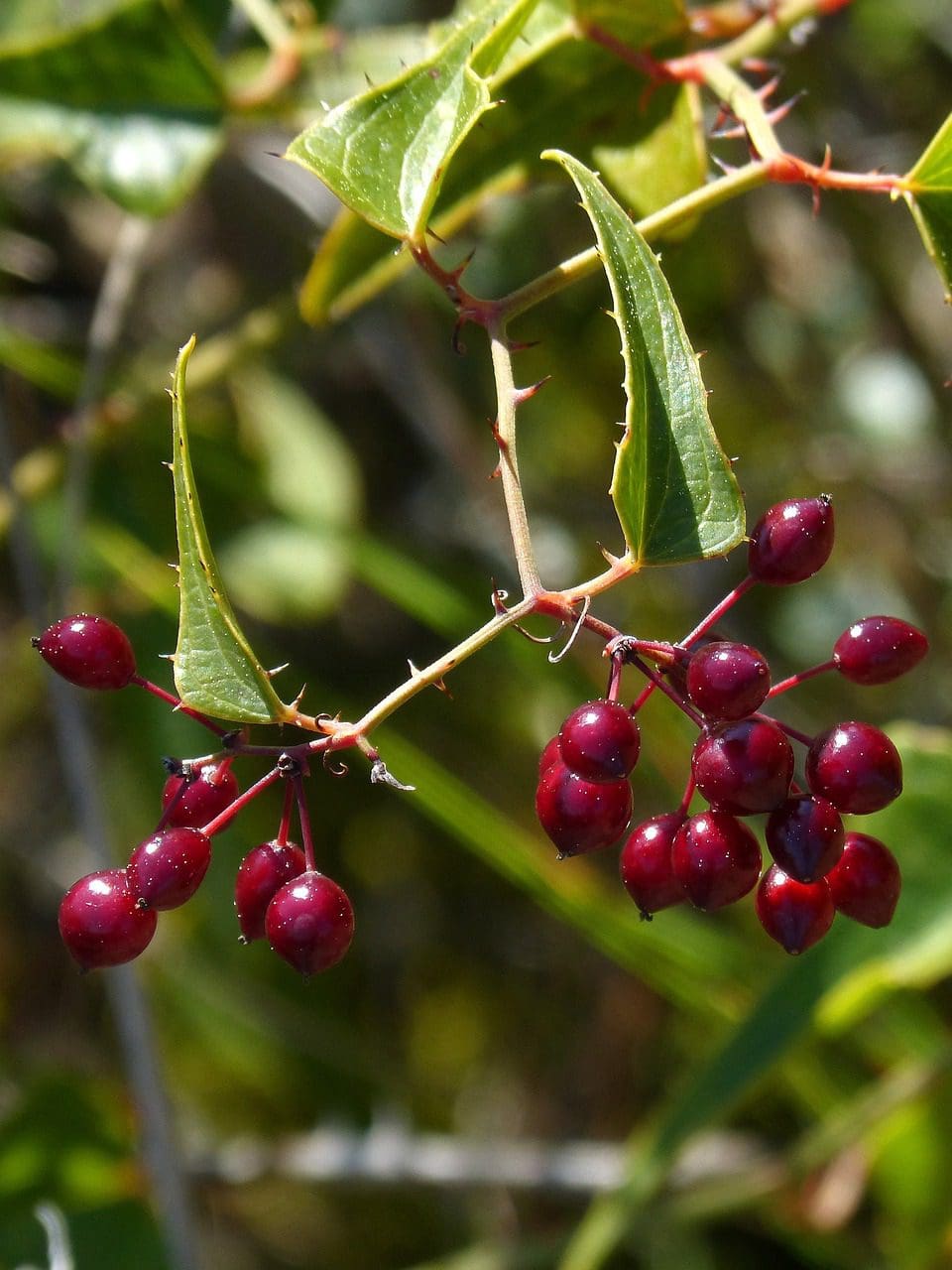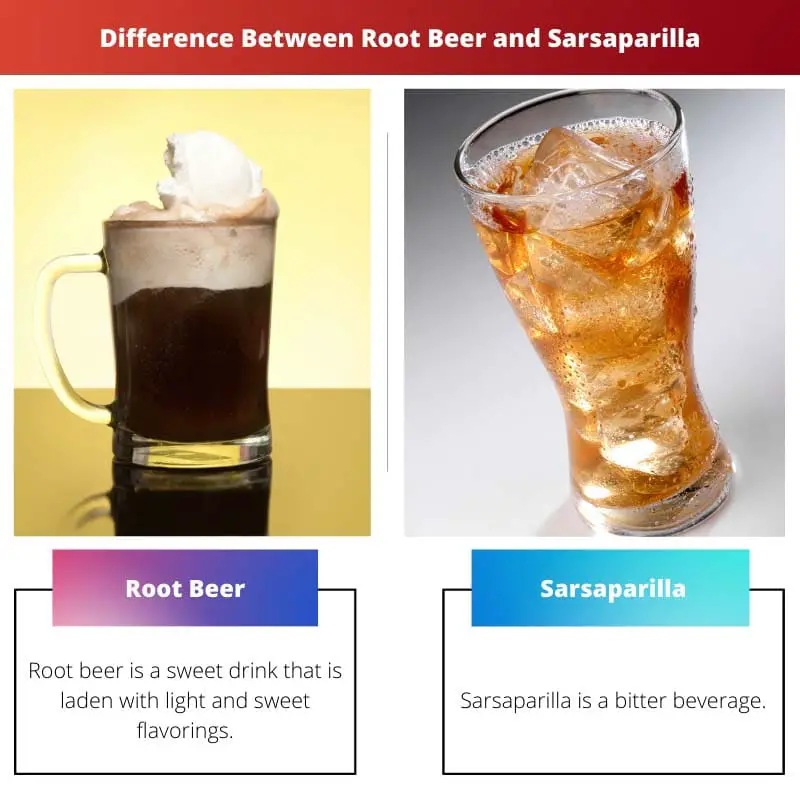Root beer and Sarsaparilla are famous beverages deeply entrenched in American Culture. They are prepared with vines and roots, are popular soft drinks, and were initially concocted as medicinal drinks or tonics previously.
Key Takeaways
- Root beer is a carbonated soft drink made from a combination of roots and herbs, with the primary flavor coming from sassafras or sarsaparilla.
- Sarsaparilla is a type of plant whose root is used to create beverages, including root beer and traditional medicines.
- Root beer tastes are sweet and creamy, while sarsaparilla has a more earthy and bitter flavor profile.
Root Beer vs Sarsaparilla
Root beer is a sweet North American beverage traditionally made using the root of the sassafras tree or the sarsaparilla vine as the primary flavor. Sarsaparilla is a soft drink, originally made from the Smilax ornata plant, which has a taste that is slightly bitter and not as sweet as root beer.

Root beer is a beverage prepared by combining various roots and ingredients such as wintergreen, vanilla, and cinnamon. Whereas, Sarsaparilla is inherently a plant with woody and small vines. The beverage ‘sarsaparilla’ is made from this plant.
Root beer is dark brown and can be an alcoholic, non-alcoholic, carbonated, or non-carbonated drink. Whereas, Sarsaparilla is a drink of medicinal value. It is used to cure skin diseases and acts as a blood purifier and an aphrodisiac.
Comparison Table
| Parameter of Comparison | Root Beer | Sarsaparilla |
|---|---|---|
| History | Established by Charles Elmer Hires in 1875 and presented as a commercial drink. | They were initially used as a medicinal drink by Native Americans. |
| Flavour | Root beer is a sweet drink laden with light and sweet flavourings. | Sarsaparilla is a bitter beverage |
| Purpose | Root beer can come in the form of an alcoholic, non-alcoholic, carbonated, or non-carbonated drink. | Initially used as a medicinal drink and later became famous as a beverage. |
| Ingredients | Along with the sarsaparilla plant, there are a few more flavouring ingredients like- aspartame, cinnamon, nutmeg, honey, anise, and wintergreen. | They are concocted by crushing the roots of the sarsaparilla plant. |
| Safety and health | Initially, root beer was made from the bark of the sassafras plant, which had a cancer-causing oil. Now, this ingredient has been scrapped due to health concerns. | It helps cure syphilis and is an anti-inflammatory agent and an antioxidant. |
What is Root Beer?
Charles Elmer developed root beer Hires in 1875 as a commercial beverage. It is prepared from the sarsaparilla plant and other ingredients.
Charles wanted to name the drink “root tea initially” but then decided to use “root beer” in its place to increase sales among coal miners in Pennsylvania.
In the 1890s, Non-alcoholic substitutes became accessible as root beer became popular.
Root beer can come in the form of an alcoholic, non-alcoholic, carbonated, or non-carbonated drink. All brands use sodium benzoate as a preservative.
The new-age root beers are sweet, carbonated, foamy, contain flavoured artificial sassafras, and are non-alcoholic.
There are various other flavours of root beer other than sassafras. Some are burdock, ginger, cinnamon, anise, dandelion, sarsaparilla, wintergreen, juniper vanilla, etc.
Molasses, honey, aspartame, maple, corn syrup, and sugar are used to sweeten the drink.
The root-bark extract- ‘safrole’ of sassafras, is prohibited by the FDA for the preparation of root beer in the USA. The extract is said to have cancer-causing oils and is unsafe and unhealthy for consumption.
Root beer production is carried out prominently in America, but different versions are also produced in the Philippines and Thailand.
Root beer is prepared by boiling water and molasses syrup. After the syrup is cooked, it must be cooled down for 3 hours. Then, along with yeast, ingredients like sassafras bark, sassafras root, and wintergreen are added to the syrup.
It is then fermented for 12 hours and then strained and rebottled to carry out the second fermentation until we obtain an alcoholic beverage of 2%. More fermentation leads to an increase in alcohol content.
Traditionally root beer brewing must have originated because it was known that mixing fermented, low alcohol content drinks with nutritional and medicinal ingredients will improve health.

What is Sarsaparilla?
We derive the word “sarsaparilla” from the term “zarzaparilla”, which means “brambly vine.” After the Spanish people were introduced to the plant by the Native Americans, they took it to Europe.
It is said that sarsaparilla was used by people way before root beer, and due to its bitter taste, its dislike paved the way for the formation of root beer. Nevertheless, sarsaparilla continued to be a popular beverage and still is.
Different plant variations are available in the temperate and tropical parts of the western hemisphere. The vine of the sarsaparilla plant bears small, dark purple, greenish-red berries.
The pulp gathered from the root of the plant is mildly bitter. To sweeten the extract, ingredients such as liquorice and wintergreen are regularly used.
Sarsaparilla constitutes minerals like iodine, iron, silicon, zinc, manganese, copper, etc. It also has vitamins A, B-complex, C and D. Sarsaparilla is an antioxidant with toxic and anti-inflammatory properties.
It helps treat skin diseases and is also a blood purifier and aphrodisiac.
From the 15th to the 19th century, the extracts from the American sarsaparilla came in handy for treating syphilis. This initiated its export to other countries.
Even though the sarsaparilla plant proved very useful against syphilis, its effectiveness was always questioned. Nevertheless, sarsaparilla has always had only positive effects on people.

Main Differences Between Root Beer and Sarsaparilla
- The main difference between root beer and sarsaparilla arises from the taste of the beverages. While root beer is a sweet drink, sarsaparilla is relatively bitter.
- The ingredients used to form root beer are – sarsaparilla plant, aspartame, cinnamon, nutmeg, honey, anise, and wintergreen. Whereas for preparing the sarsaparilla beverage, the only ingredient required is the sarsaparilla plant.
- Root beer is available in alcoholic, non-alcoholic, carbonated, or non-carbonated. Whereas sarsaparilla was mainly a medicinal drink and later came into use as a beverage too.
- Root beer was initially made with the bark of the sassafras plant, which was later banned due to its cancer-causing oils. On the other hand, sarsaparilla helps cure syphilis and is an anti-inflammatory and antioxidant agent.
- Charles Elmer established root beer Hires in 1875 and presented it as a commercial drink. Sarsaparilla, on the other hand, was discovered by Native Americans.

- https://online.ucpress.edu/abt/article-pdf/57/7/432/47358/4450033.pdf
- https://thesunlightexperiment.com/blog/2017/5/21/what-is-sarsaparilla-root

The historical narrative of sarsaparilla preceding the emergence of root beer is quite thought-provoking. It’s fascinating to explore the connections between these beverages and the evolution of tastes over time.
Absolutely, the chronological context provides an insightful perspective on the development of these iconic beverages.
I agree, it’s intriguing to trace the historical lineage of sarsaparilla and its influence on the creation of root beer.
The diverse variations of the sarsaparilla plant are quite fascinating. It’s amazing to learn about the botany behind these popular beverages, adding an extra layer of complexity to the discussion.
Agreed, the discussion on different plant variations adds depth to the discourse on sarsaparilla and its rich heritage.
Absolutely, the botanical insights contribute to a more comprehensive understanding of sarsaparilla and its cultural significance.
I find it fascinating that these popular beverages root beer and sarsaparilla have such deep cultural roots in American society. The comparison of the flavors and medicinal properties was quite informative and captivating.
I agree, it’s interesting to learn about the history and differences between root beer and sarsaparilla.
The historical and cultural background of root beer and sarsaparilla is fascinating. It’s wonderful to delve into the rich tapestry of American beverage traditions and their global impact.
I agree, exploring the historical and cultural dimensions of these beverages offers a captivating perspective on American heritage and influence.
Absolutely, the historical narrative adds depth to the understanding of American beverage culture and its enduring legacy.
The comparison table provides a clear and concise summary of the key differences between root beer and sarsaparilla. Very helpful information for anyone who wants to understand the distinctions between these beverages.
I particularly appreciate the historical context provided for both root beer and sarsaparilla. It adds depth to the discussion.
Absolutely, the information is quite enlightening and presented well.
I found it quite amusing to learn about the origins of the word ‘sarsaparilla’. It’s intriguing how language and culture intertwine in the history of these beverages.
Indeed, the linguistic origins offer an interesting perspective on the cultural aspects involved in the history of sarsaparilla.
True, the etymology of the word ‘sarsaparilla’ sheds light on its historical journey and cultural significance.
The detailed explanation of the production process for root beer and sarsaparilla is truly enlightening. It’s amazing to learn about the intricate methods involved in creating these beverages.
Absolutely, the detailed process descriptions provide a deeper understanding of the craftsmanship behind these drinks.
The comparison of the ingredients used in root beer and sarsaparilla is quite intriguing. It’s remarkable how the composition of these beverages contributes to their unique tastes and properties.
Definitely, I found it intriguing how the ingredients contribute to the distinct flavors of root beer and sarsaparilla.
Agreed, it’s quite insightful to understand the impact of the ingredients on the final products.
The thorough comparison of root beer and sarsaparilla is quite enlightening. It provides a comprehensive understanding of the historical, cultural, and botanical aspects shaping these iconic beverages.
Absolutely, the multi-faceted comparison offers a rich exploration of the intricate details involved in the production and cultural significance of these drinks.
The cautionary note about the historical use of sassafras plant and its health concerns in root beer production is quite important. It’s crucial to be aware of the evolving safety considerations in the preparation of these beverages.
Agreed, the focus on health and safety aspects in the production of root beer adds a layer of social responsibility to the conversation.
Definitely, the emphasis on health standards and regulatory changes highlights the responsible consumption of root beer.